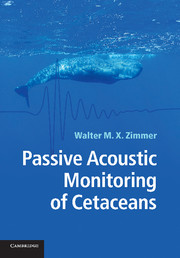Book contents
- Frontmatter
- Contents
- Acknowledgements
- Introduction
- Part I Underwater acoustics (the basics)
- Part II Signal processing (designing the tools)
- 4 Detection methods
- 5 Classification methods
- 6 Localization and tracking
- Part III Passive acoustic monitoring (putting it all together)
- References and further reading
- Index
5 - Classification methods
Published online by Cambridge University Press: 26 April 2011
- Frontmatter
- Contents
- Acknowledgements
- Introduction
- Part I Underwater acoustics (the basics)
- Part II Signal processing (designing the tools)
- 4 Detection methods
- 5 Classification methods
- 6 Localization and tracking
- Part III Passive acoustic monitoring (putting it all together)
- References and further reading
- Index
Summary
The objective of this chapter is to introduce the classification of detected objects, that is, to assign the detected signals (clicks or whistles) to different cetacean species. We will concentrate on two approaches, namely classification based on ‘single’ and on ‘multiple’ signals. Single-signal-based classification exploits the features that are intrinsic to each cetacean sound emission and that may be done in both the time and the spectral domain. Multiple-signal-based classification requires the detection of more than one signal of the same species to perform the classification.
Classification basics
Classification is the process that assigns measurements to distinct classes and is of importance when there are multiple solutions to the allocation process. We have already addressed the data allocation process for the whistle tracker, where we implemented a simple and straightforward allocation algorithm. General classification problems are similar, but instead of needing to assign a single frequency to one of the whistles, we have a vector of measurements, or feature vector, which we wanted to assign to a class.
To demonstrate the problem, let us assume that our click detector generates for each detection a simple 3-element feature vector, e.g. signal length, spectral bandwidth and frequency of spectral peak. The task for the classification algorithm is then to take this feature vector and ideally to tell the user which species generated the click.
- Type
- Chapter
- Information
- Passive Acoustic Monitoring of Cetaceans , pp. 164 - 197Publisher: Cambridge University PressPrint publication year: 2011
- 1
- Cited by



